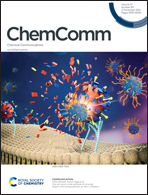Advances in silylation and borylation of fluoroarenes and gem-difluoroalkenes via C–F bond cleavage
Abstract
Organoboron and organosilane compounds are widely used in organic synthesis and pharmaceuticals. In addition, the C–F bond functionalization is a useful tool for the construction of carbon–carbon and carbon–heteroatom bonds. In particular, the late-stage functionalization of bioactive molecules through defluoroborylation and defluorosilylation reactions will provide good opportunities for the development and diversification of new medicinal compounds. Thus, this feature article summarized the methods for the defluorosilylation and defluoroborylation of unreactive monofluoroarenes and gem-difluoroalkenes from 2000 to 2021, which might create some new ideas and will be helpful for further research in this field. These defluoroborylation and defluorosilylation strategies can be applied to synthesize silylated arenes, borylated arenes, silylated fluoroalkenes, and borylated fluoroalkenes, thus providing impressive advantages over traditional methods for the synthesis of organoboron and organosilane compounds in terms of divergent structures.



 Please wait while we load your content...
Please wait while we load your content...